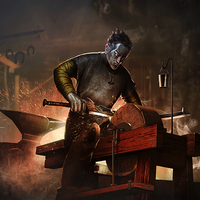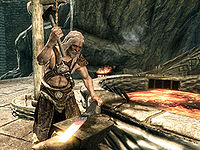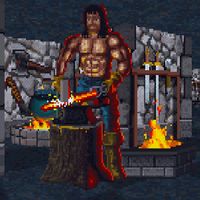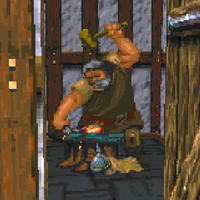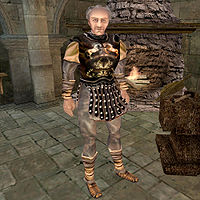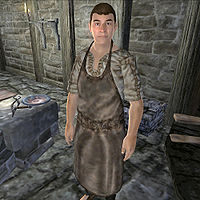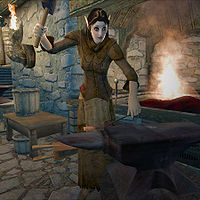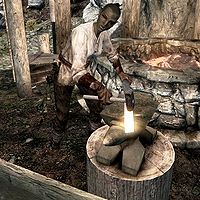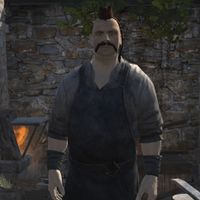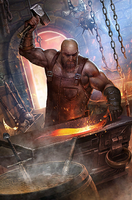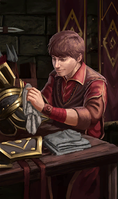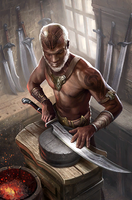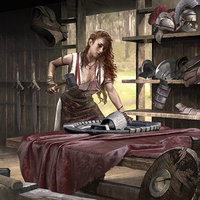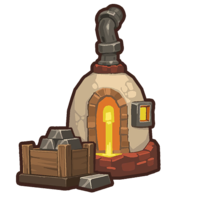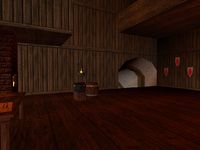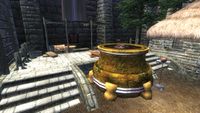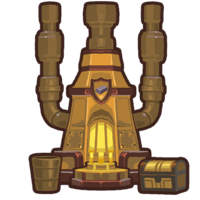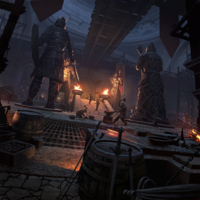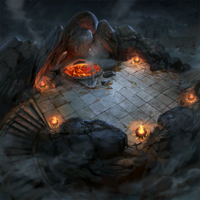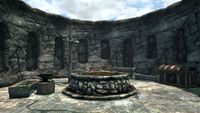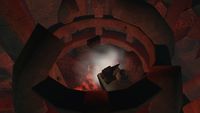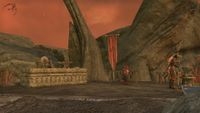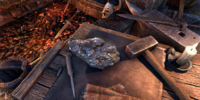Lore:Smithing
Smithing or blacksmithing is the act and art of working and forging metals, such as iron, into any desired shape.[1][2] Metalworking is the process of shaping metals to smith new items. Metallurgy is the process of producing and purifying metals through techniques such as smelting and casting.[3]
Contents
Institutions[edit]
Tamriel[edit]
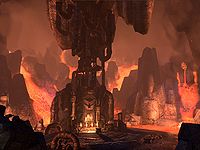
Various cultures and organizations had their own approaches to the art of smithing, each making unique contributions and choices, including distinctive styles and materials.[4][5] For instance, Highland Bretons are credited with the invention of the claymore.[6]
Smiths were employed by the Fighers Guild, and numerous Templar Knightly Orders.[7][8]
The Morkul Clan of Wrothgar are well regarded across Orcish society as master smiths and metalworkers.[9] Chief among them was the ancient smith, Nuzava, who defined the Morkul Clan's distinctive style of weapons and armor.[10] Coins minted in the furnaces of Old Orsinium are now considered rare and valuable.[11]
During the Akaviri Potentate in 2E 321, Versidue-Shaie gave his approval for the Guild Act, which sanctioned numerous guilds and businesses. For example, the Act officially sanctioned the Tinkers Guild, a guild established for itinerant tinsmiths.[12] As of 2E 582, smiths were already benefiting as a result of the Guild Act. The establishment of pan-Tamrielic guilds resulted in greater diffusion of knowledge, which allowed many smiths to learn of interesting metals used only in distant lands, and this drove demand and trade for those materials.[13] All the sanctioned guilds named in the Guild Act, and those formed later, were thereafer protected by the Empire of Cyrodiil, even into the Third Era, but would be required to pay if they wanted to expand their influence. The Empire was strengthened by the Guild Act,[12] and the creation of guilds was considered beneficial for the Tamriel as a whole.[14]
The Daggerfall Covenant was known to have some of the finest blacksmiths in Tamriel in its time.[15]
During the Second Era, smiths frequently utilized distinctive materials to create diverse armors and incorporated unique gemstones and minerals to enhance their craft, improving their equipment with unique qualities.[5][16][17] Skilled blacksmiths possessed the ability to decipher the metal's inherent qualities, allowing them to select the most suitable trait during the forging process, provided they had conducted thorough research. Furthermore, they could enhance the item's sharpness, add extra weight, and make other alterations if necessary. To achieve advanced levels of craftsmanship, they used various style books, which circulated throughout Tamriel at that time. A small variety of tempers were employed to make armor and weapons stronger and more resistant.[18][19] To obtain official recognition as a Smith, one had to pass a certification test held in many of the major cities.[20][17] Obtaining such certificates enabled the smiths to accept a diverse range of contracts.[21]
As of 3E 405, smiths in the region of the Iliac Bay were often hired to craft weapons and armors, as well as to do some repairs at various stores. They were also known to train apprentices. The goldsmiths were known to create necklaces, rings, bracelets, and occasionally armor. Silversmiths worked with silver and mithril, and crafted weapons made of those materials. Ebonysmiths were known for their ebony products.[22]
Circa 3E 427, the Vvardenfell Fighters Guilds and Redoran smiths forged armor specifically designed for women.[23]
Oblivion[edit]
The mortal inhabitants of the Shivering Isles have two specialized smithing traditions, namely the smithing of amber and madness ore. By long tradition, the city of New Sheoth houses two rival master smiths: the amber smith of Bliss, and the madness ore smith of Crucible.[24][25] By 4E 201, these crafting methods had spread to Tamriel after a master arcane blacksmith named Evethra managed to learn the secrets of working with these materials, albeit losing her mind in the process.[26][27]
The realm of Fargrave possesses a crafting plaza where mortal and Daedric smiths alike gather from across the planes to trade and practice their craft.[28][29] The Saraathu Tong employed mage-smiths. Numerous blacksmiths incorporate magic into their work, but smithing through magic is considered far more uncommon.[30]
The Hollow City in Coldharbour has on occasion possessed mortal blacksmiths, who ply their craft in the hostile realm under Meridia's protection.[31] Black Forge is located in southeastern Coldharbour, and is a massive facility where Molag Bal's troops have their arms and armor forged.[32][33]
Notable Smiths[edit]
- Asterie Bedel — Breton smith, master of both mannish and merish techniques and creator of Chrysamere.
- Bthuand Mzahnch — Dwemer smith, tonal architect and a student of Kagrenac. Author of The Egg of Time.
- Dahrk Mezalf — Dwemer smith, tonal architect and a student of Kagrenac.
- Eorlund Gray-Mane — Keeper of the famous Skyforge at the Jorrvaskr Mead Hall for the Companions, widely regarded as the best blacksmith in Skyrim during his time.
- Gherig Bullblood — Reachman keeper of the Bloodroot Forge and patriarch of the Dreadhorn Clan.
- Haj-Ja — Famous Argonian smith of the Second Era.
- Haman Forgefire — The greatest smith in Skyrim, who crafted the legendary Okin and was murdered by his rival.
- Hazadir — Famous Argonian smith in service of Empress Katariah.
- Hervic Fambure — Master smith of Betony.
- Hilbongard Rolamus — Forger of the artifact Skull Crusher.
- Kagrenac — Renowned Dwemer mage-smith and Tonal Architect, responsible for the creation of the original Brass God, Anumidium.
- Kyanka — Altmer smith and enchanter, responsible for the creation of the Mace of Slurring.
- Lirulorne — Renowned Ayleid smith, responsible for crafting Al-Esh Ascension Coins.
- Merric at-Aswala — Leader of the Fighters Guild responsible for reforging the Prismatic Core into a weapon.
- Mithas — Greatest of the Dwarven blacksmiths.
- Naenra Waerr — Crafter of the Daedric artifact Umbra for Clavicus Vile.
- Nuulion — Master smith of Summerset Isle and confidant of the secret to forging Elven armor.
- Nuzava — An ancient and highly-respected smith of the Morkul Clan.
- Orgnum — King of Pyandonea, rumored to be the first silversmith in history.
- Radac Stungnthumz — Dwemer weaponsmith who played a crucial role in the process of reforging and reigniting Trueflame.
- Sirollus Saccus — Master blacksmith for the Imperial Legion who is among the longest-lived men in recorded history.
- Stoneheart — Reachman Bloodforge Smith and a prominent member of the Dreadhorn Clan.
- Tansal — One of the Sword-singer heroes.
- Valindor — An apprentice of master armorer of Silvenar and descendant of Lord Harkon's bloodline.
- Yagak gro-Gluk — The best blacksmith in Mournhold, who reforged Trueflame.
- Yngol — Son of Ysgramor, remembered as the greatest Atmoran blacksmith.
Notable Forges[edit]
- Aetherium Forge
- Anudnabia
- Ashen Forge
- Atronach Forge
- Black Forge
- Bloodroot Forge
- Bone Forge
- Earth Forge
- Infernium Forge
- Lunar Forge
- Morkuldin Forge
- Skyforge
Spread across Tamriel are many other unnamed forges which provide unique effects to weapons, armor and jewelry created in such places.[34] The creative skill of the smiths who have worked these forges has imbued the sites with the divine spark of creativity, transforming the local reality such that items crafted there possess certain unique attributes.[35] Among such places were the forges located at the Ayleid ruin of Sariellen's Sword,[36] and Druadach Redoubt.[37] Yet another example is Night's Silence, which was created by the mad wizard Mesanthano due to the arcane power which still lingers in places such as his ruined tower.[38]
Artifacts[edit]
Some legendary artifacts are associated with the art of smithing:
- Anvil of Mithas — A legendary Dwarven anvil, twinned with the Hammer of Gharen
- Golden Anvil — Sacred relic of Zenithar
- Hammer of Gharen — A Dwarven hammer twinned with the Anvil of Mithas
- Nuzava's Anvil — A legendary Orcish anvil, which belonged to master smith Nuzava
Notes[edit]
- In concept art for The Elder Scrolls V: Skyrim, Markarth was depicted as having a Smith Guild.[UOL 1]
Gallery[edit]
Smiths[edit]
Forges[edit]
Other[edit]
A constellation representing Smithing
See Also[edit]
- For game-specific Smithing information, see the Morrowind, Oblivion, Blades, Skyrim and ESO articles.
Books[edit]
- From Wrothgar to Lilmoth: A Smith's Tale by Garnozag, Master Smith — An account of Argonian weaponmaking methods from an Orc smith's perspective
- Nord Armorers and Armsmen — Notes on Nordic blacksmithing culture and techniques
References[edit]
- ^ Smithing: A Worthy Endeavor — Cuinaamo, Great Sage of the Forge
- ^ Blacksmithing Basics — Zeg gra-Dush
- ^ Blacksmithing skills in ESO
- ^ Crafting Motifs — Doctor Alfidia Lupus and Seif-ij Hidja
- ^ a b Style Materials in ESO
- ^ Garothmuk gro-Muzgub's dialogue in Morrowind
- ^ Sabine Laul's dialogue in Oblivion
- ^ Knightly Orders in Daggerfall
- ^ King Kurog's dialogue in ESO: Orsinium
- ^ Nuzava's Anvil
- ^ Old Orsinium Coins description
- ^ a b History of the Fighters Guild
- ^ Master Assistant Materials Acquirer Pacrooti Answers Your Questions — Pacrooti
- ^ Avita Pitio's dialogue in ESO: Elsweyr
- ^ Loading screen tip in Legends
- ^ Trait Materials in ESO
- ^ a b Millenith's dialogue in ESO
- ^ Maesa's dialogue in ESO
- ^ Tempers in ESO
- ^ Events of Blacksmith Certification in ESO
- ^ Events of Blacksmith Writ in ESO
- ^ Blacksmith, Apprentice, Goldsmith, Silversmith and Ebonysmith greetings in Arena
- ^ LeFemm Armor in Morrowind
- ^ Cutter's dialogue in Oblivion: Shivering Isles
- ^ Dumag gro-Bonk's dialogue in Oblivion: Shivering Isles
- ^ Note on Amber and Madness Ore — Thoron
- ^ Evethra's Journal — Evethra
- ^ Fessoshaz's dialogue in ESO: The Deadlands
- ^ Ioloola's dialogue in ESO: The Deadlands
- ^ Ravam Drom's dialogue in ESO: The Deadlands
- ^ Bends-Iron's dialogue in ESO
- ^ The Prophet's dialogue during Daughter of Giants in ESO
- ^ Projection of Vanus Galerion's dialogue during Vanus Unleashed in ESO
- ^ Felarian's dialogue in ESO: Summerset
- ^ Master Assistant Materials Acquirer Pacrooti Answers Your Questions — Pacrooti
- ^ Sariellen's Sword in ESO: Blackwood
- ^ Druadach Redoubt in ESO: Markarth
- ^ Mesanthano's Tower
Note: The following references are considered to be unofficial sources. They are included to round off this article and may not be authoritative or conclusive.
- ^ Skyrim Concept Art by Adam Adamowicz
| ||||||||
| ||||||||||||||
